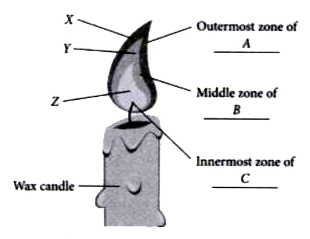The hottest zone in the candle flame is the
non-luminous zone
luminous zone
invisible zone
all zones are equally hot.
The correct Answer is:A
Step-by-Step Solution:
1. Understanding Candle Flame Zones: A candle flame consists of different zones, each with varying temperatures and combustion characteristics. The main zones are the non-luminous zone, luminous zone, and the dark zone.
2. Identifying the Hottest Zone: The hottest zone in a candle flame is known as the non-luminous zone. This zone is characterized by complete combustion of the wax (fuel) with oxygen.
3. Reason for High Temperature: The non-luminous zone has an excess supply of oxygen, which allows for complete combustion. This results in a higher temperature compared to other zones.
4. Color of the Hottest Zone: The non-luminous zone is typically blue in color, indicating that the combustion is efficient and complete.
5. Comparison with Other Zones:
- Luminous Zone: This zone is where partial combustion occurs, leading to a moderate temperature and a yellowish flame.
- Dark Zone (Invisible Zone): This zone has no supply of oxygen and is the least hot, often referred to as the dark zone.
6. Conclusion: Based on the characteristics of each zone, the hottest zone in the candle flame is the non-luminous zone.
Final Answer: The hottest zone in the candle flame is the non-luminous zone.
---
- Luminous Zone: This zone is where partial combustion occurs, leading to a moderate temperature and a yellowish flame.
- Dark Zone (Invisible Zone): This zone has no supply of oxygen and is the least hot, often referred to as the dark zone.
Topper's Solved these Questions
- COMBUSTION AND FLAME BOOK - MTG IIT JEE FOUNDATIONCHAPTER - COMBUSTION AND FLAME EXERCISE - EXERCISE (MATCH THE FOLLOWING) LEVEL 1
5 Videos
- COMBUSTION AND FLAME BOOK - MTG IIT JEE FOUNDATIONCHAPTER - COMBUSTION AND FLAME EXERCISE - EXERCISE (ASSERTION & REASON) LEVEL 1
10 Videos
- COMBUSTION AND FLAME BOOK - MTG IIT JEE FOUNDATIONCHAPTER - COMBUSTION AND FLAME EXERCISE - NCERT SECTION
18 Videos
- COAL AND PETROLEUMBOOK - MTG IIT JEE FOUNDATIONCHAPTER - COAL AND PETROLEUMEXERCISE - OLYMPIAD/HOTS CORNER
10 Videos
- FOOTSTEPS TOWARDS (JEE MAIN)BOOK - MTG IIT JEE FOUNDATIONCHAPTER - FOOTSTEPS TOWARDS (JEE MAIN)EXERCISE - SECTION B (NUMBERIC VALUE TYPE QUESTIONS)
10 Videos
Similar Questions
Knowledge Check
The outermost zone of a candle flame is the :
Aleast hot partBcoldest partChottest partDmoderately hot partThe outermost zone of a candle flame is the :
Aleast hot partBcoldest partChottest partDmoderately hot part.The central zone of the candle flame is luminous due to
Aincomplete combustion of wax vapoursBcomplete combustion of wax vapoursCno combustion of wax vapoursDformation of carbon dioxide.
Name the various zones of a candle flame. Which zone (or part) of a candle flame is the least hot (or coldest)?
View SolutionA flame is the visible gaseous part of a fire. It is a zone of combustion of gaseous substances accompanied by evolution of heat and light. All substances do not burn with a flame. Only those substances that vaporise during burning produce flame. A candle flame is taken to study the various zones of a flame.

Which zone of a candle flame is the zone of no combustion?
View SolutionWhich zone of a candle flame is the hottest ? ·
View SolutionWhich is the hottest part in the flame of the candle ?
View SolutionThe middle zone of a candle flame is also called the zone of _____ combustion.
View Solution
